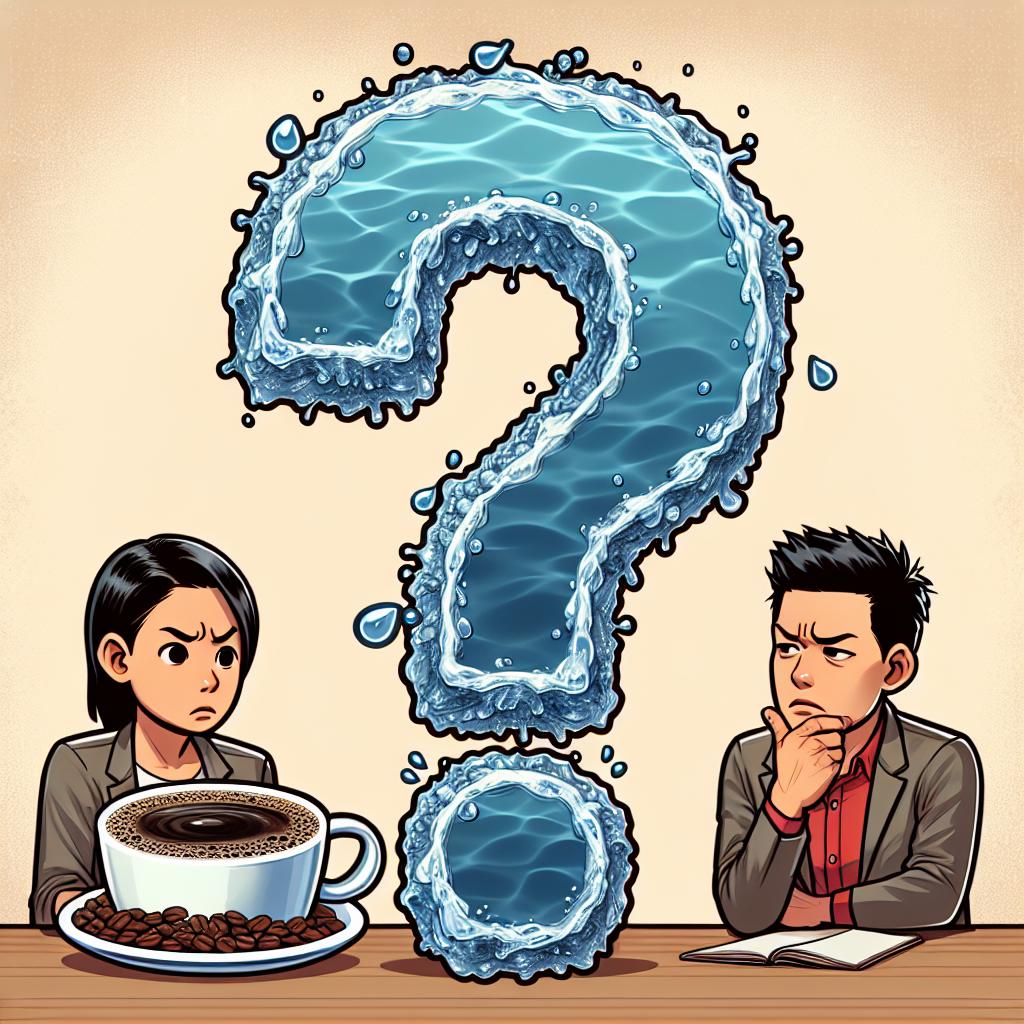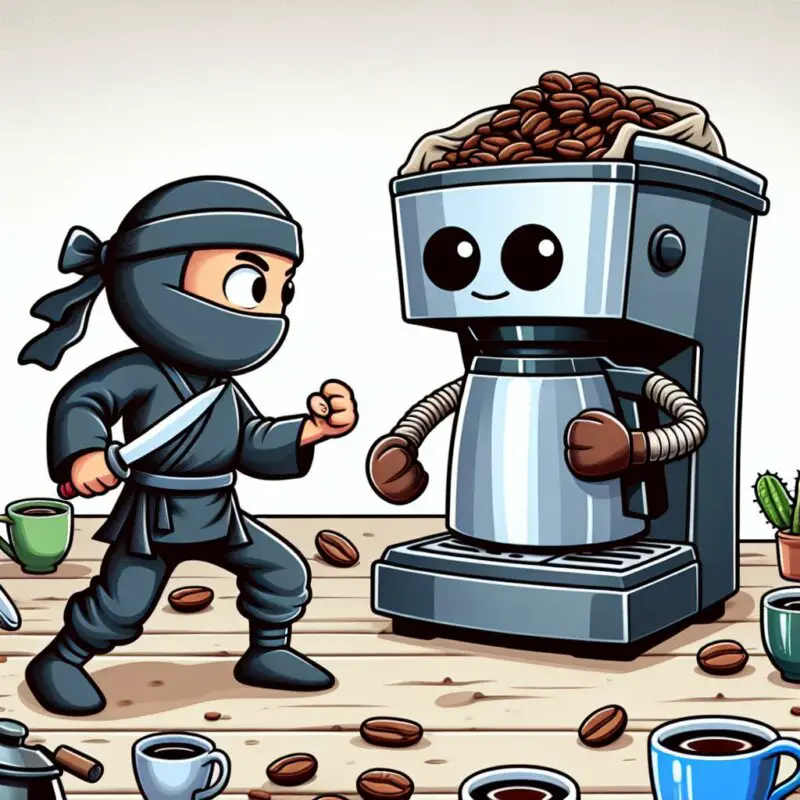This post may contain affiliate links. Please read my disclosure for more info.
You just made a fresh pot of coffee and excitedly filled your mug with that first pour. But, surprise! That first sip didn’t bring the joy you expected. Instead of rich, flavorful coffee, it tasted like bland, warm water. What a letdown!
What went wrong, you ask? Why does my coffee taste watery?
Discover why your coffee’s weak and how to make it flavorful again!
Why Does My Coffee Taste Like Water?
1. Your coffee grounds are too coarse
Watery coffee can be a real letdown, and often, it’s all about the grind. If your coffee grounds are too coarse or too fine for how you’re making your coffee, you might end up with a bland brew.
For a perfect cup, match your coffee grind to the maker. Use medium grind for drip coffee makers, coarser for French press, and fine grind for espresso machines and Moka pots. But, the versatile AeroPress works with many grind sizes.
When you grind your own coffee beans, you decide how fine or coarse they are. If you haven’t yet, consider getting an affordable coffee grinder to start.
2. You need to adjust your coffee-to-water ratio
If your coffee tastes watery, you might be using too much water for the amount of coffee grounds. Brewing coffee is like creating art, where getting the measurements right can make the difference between a delicious or disappointing cup.
Every way of making coffee needs the perfect mix of coffee and water. For drip coffee, aim for a mix between 1:15 and 1:17, often called the Golden Ratio.
In this article, I’ll share a detailed chart, but here’s a quick tip: for every six ounces of water, use two tablespoons of coffee. If you like being precise and prefer weighing, aim for 60 grams of coffee per liter of water. Stay tuned for more!
Want to perfect your coffee? If it tastes too weak, add a little more coffee grounds. But be careful not to add too much. Overdoing it can make your coffee sour, not just stronger. Keep experimenting until it’s just right!
3. Your brew time is too short
The time water spends with coffee grounds, known as extraction or brew time, is key. It shapes your coffee’s flavor and strength.
For drip coffee, aim for a 5-minute brew. Different methods might need more or less time.
Espresso is a quick coffee fix, brewing in just 20-30 seconds. On the flip side, cold brew takes its time, needing at least 24 hours to steep properly.
Just like making tea, the time you let hot water soak into the coffee grounds changes how strong your coffee is. If you rush it, you might end up with coffee that tastes too watery.
4. Your water isn’t hot enough
Did you realize that the temperature of your water affects your coffee’s flavor? Too cold, and your coffee might taste sour or thin. Too hot, and your brew could turn bitter. Keep an eye on that temperature for the perfect cup!
For the perfect drip coffee, heat your water between 195 and 205 degrees. If your coffee tastes weak, it might be because your brewer isn’t getting the water hot enough. Check its temperature!
5. You need to try a different roast
Did your coffee start tasting weak after getting a new bag of beans? It could be because you switched your coffee roast. If you love the strong, rich taste of dark roast coffee, a light roast might seem thin and watery to you.
Take a peek at your coffee bag. Does it mention light, medium, or dark roast? Sometimes, you’ll see “espresso roast,” which is another way of saying dark roast. If it talks about French or Italian roast, those are the darkest of the dark. If your new beans seem lighter than usual, you might just prefer a dark roast.
6. It could be your coffee maker
If your coffee tastes weak, your coffee maker might be the culprit. It could be messing up brew times or not heating the water right.
Having trouble with your coffee maker? Take a look at my guide on fixing Cuisinart coffee makers. Good news – these tips usually work for all drip coffee makers, not just Cuisinart!
Thinking of getting a new coffee maker? Consider switching to an automatic pour-over coffee maker for a tastier cup of coffee. Yes, they cost a bit more than the usual budget coffee makers, but the flavor boost is worth it!
7. Your water might be supbar
The water you use can really change how your coffee tastes. If your tap water isn’t great or you use softened water, try switching to filtered or bottled water for a better cup of coffee.
If you’re using tap water for your coffee, let it flow for a few seconds first. Always fill your coffee maker with cold water to get the best taste.
8. Your beans could have gone bad
Coffee doesn’t stay fresh forever. Once roasted, beans start losing their taste. Ground coffee spoils fast, and whole beans also have a limited good period. Keep this in mind to enjoy the best flavor.
When coffee beans are roasted, they release many gases. These gases carry the beans’ flavors. But, if you leave your beans forgotten in a cabinet for a year or store them wrong, they lose these gases and flavors. The result? A dull and flavorless cup of coffee.
Coffee Measurements Are Key
If your coffee tastes weak, you might not be using enough coffee grounds for the water. Getting your measurements right is key to making a great cup of coffee every time. Start measuring carefully for better brews!
To make the perfect cup of coffee, you’ll need a handy coffee scale that measures in grams. It’s a game-changer for measuring both your water and coffee grounds with precision. A good starting point is using 500 grams of water for every 30 grams of coffee. Feel free to tweak these amounts to get your brew just right!
No kitchen scale? No problem! Just use the guide below to see how much water and coffee you need. Whether you’re using tablespoons or coffee scoops, we’ve got you covered. It’s easy to make the perfect cup, even for beginners.
Coffee fact: A coffee pot cup is 6 ounces, not the 8 ounces you’re familiar with.
| Coffee (cups) | Water (ounces) | Grounds (tablespoons) | Grounds (scoops) |
|---|---|---|---|
| 1 | 6 | 2 | 1 |
| 2 | 12 | 4 | 2 |
| 3 | 18 | 6 | 3 |
| 4 | 24 | 8 | 4 |
| 5 | 30 | 10 | 5 |
| 6 | 36 | 12 | 6 |
| 7 | 42 | 14 | 7 |
| 8 | 48 | 16 | 8 |
| 9 | 54 | 18 | 9 |
| 10 | 60 | 20 | 10 |
| 11 | 66 | 22 | 11 |
| 12 | 72 | 24 | 12 |
Want a stronger coffee? Simply use more grounds next time. Think of these tips as guidelines, not strict rules. Happy brewing!
Quick Fixes for Watery Coffee
Got a weak coffee in your cup? Don’t pour it out! Let’s turn that watery brew into a delicious drink. Here’s how!
- Add milk/cream
Liven up your coffee by adding milk or cream. For a fun twist, froth your milk to give it a creamy texture. If you’re lactose intolerant, almond and oat milk are great alternatives. Don’t let a weak brew get you down!
- Toss in some instant coffee
Believe it or not, a pinch of instant coffee can make your cup richer and bolder, enhancing its flavor. For an extra boost, try having some Vietnamese instant coffee on hand. It’s a game-changer!
Why Does My Keurig Coffee Taste Watery?
K-cups handle the measuring, but why does your Keurig brew watery coffee? Let’s find out.
If your coffee isn’t coming out right, you might need to clean your Keurig needle. A clogged needle can mess up the water flow and coffee brewing. Clearing it out usually fixes the problem.
Remember, older Keurig machines often brewed coffee that was a bit on the watery side. For a tastier cup, think about switching to a K-Supreme Plus Smart. Or, for even richer flavors, a Nespresso Vertuo machine could be your go-to.
What’s Next?
After fixing watery coffee, let’s explore more ways to make your morning brew better. Do you enjoy flavored coffees or prefer third-wave coffee? You should have the perfect cup that delights your taste buds.
Elevate your coffee game by switching to whole bean coffee and using a quality grinder. Why not explore new sweeteners or try more robust beans too? My goal isn’t to choose your path, but to give you the tools and ideas to make your coffee journey exciting.



